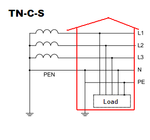boylesg
Advanced Member level 4
- Joined
- Jul 15, 2012
- Messages
- 1,023
- Helped
- 5
- Reputation
- 10
- Reaction score
- 6
- Trophy points
- 1,318
- Location
- Epping, Victoria, Australia
- Activity points
- 11,697
From an electrical grounding point of view, it would be ideal if the whole planet was made of superconducting material (cue Star Trek...) and everywhere had the same reference voltage to work against. However, that isn't even close to reality and the best we have is whatever is beneath our feet. Being kind to our planet, the moisture and dissolved conductive elements in the crust are reasonably good conductors, at least in most inhabitable places. The more contact area your house (or Tesla coil) earth has with the physical ground, the more likely it is to have good conductivity to elsewhere. The minimum depths for Earth connections are to maximize the likelyhood of a good connection.
You probably also have a wired connection from the AC outlet Earth pin to your nearest distribution transformer where it will be linked to neutral and also given a good connection to 'real planet' Earth rods. This is for electrical safety purposes and to allow safety devices (RCCB, ELCB etc) to operate but it does provide you with a reasonably clean ground reference.
Taking your Tesla coil as an example although the same principle applies to your transmitter, it generates high voltage between two places. If you didn't Earth one of them, it would be as 'live' as the other. You probably don't want high voltage arcs from the bottom of the coil, probably taking the easiest electrical route which would be through the coil primary and driver circuits!
Brian.
So this is the context of your comment about earthing the neutral, but I don't get it Brian.
And why is Earthing the neutral pin in a wall socket more of an electrocution risk than earthing the neutral pin at the street pole?
As was pointed out earthing either AC pin will result in shorting current to earth.
So why would anyone do that at any point in the distribution system?
And why is earthing the neutral of a wall socket more of an electrocution risk than earthing the neutral at the pole pig?
Last edited:
